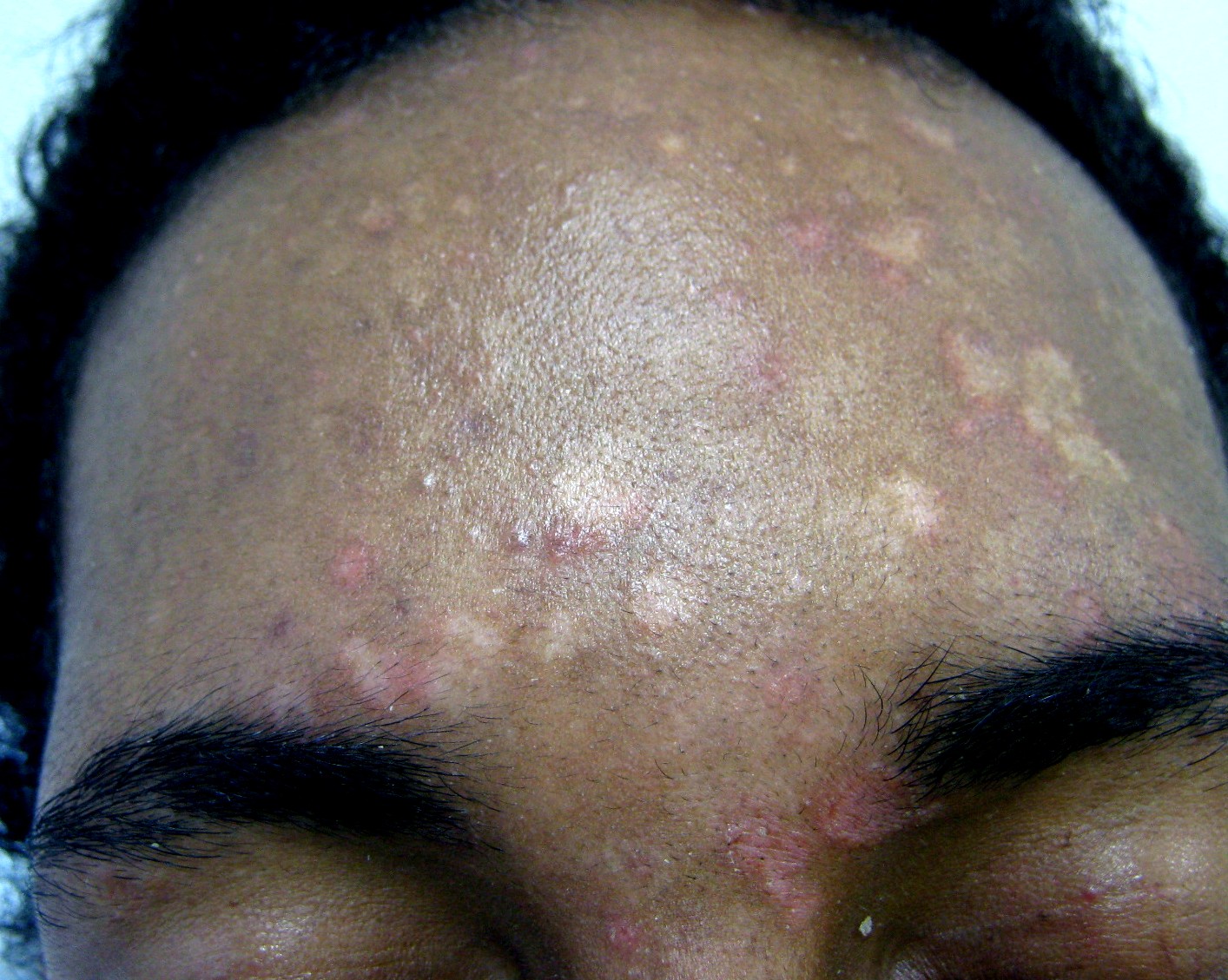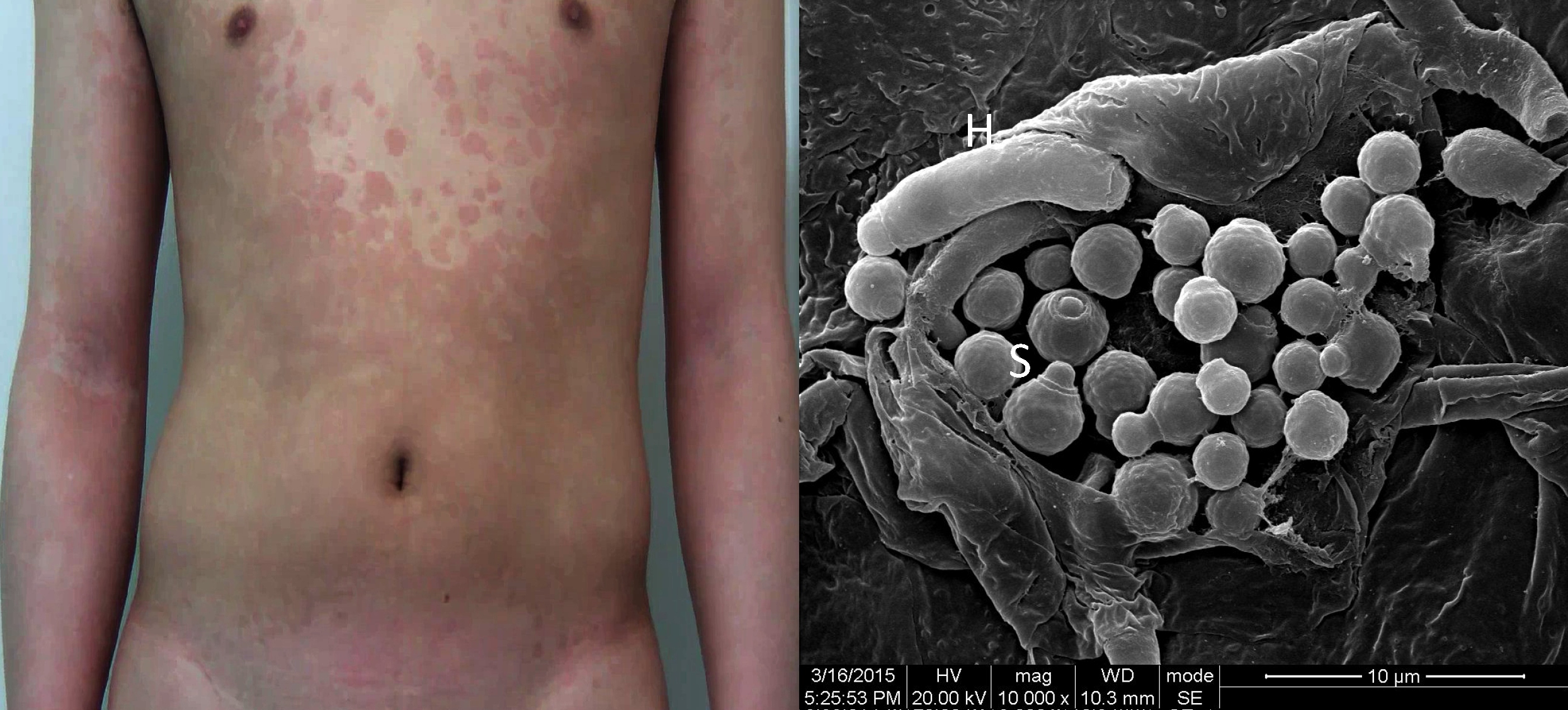Tinea Versicolor on:
[Wikipedia]
[Google]
[Amazon]
Tinea versicolor (also pityriasis versicolor) is a condition characterized by a skin eruption on the trunk and proximal extremities. The majority of tinea versicolor is caused by the fungus '' Malassezia globosa'', although '' Malassezia furfur'' is responsible for a small number of cases. These

 The signs of this condition include:
* Occasional fine scaling of the skin producing a very superficial ash-like scale
* Pale, dark tan, or pink in color, with a reddish undertone that can darken when the patient is overheated, such as in a hot shower or during/after exercise. Tanning typically makes the affected areas contrast more starkly with the surrounding skin.
* Sharp borderPityriasis versicolor , DermNet New Zealand
The signs of this condition include:
* Occasional fine scaling of the skin producing a very superficial ash-like scale
* Pale, dark tan, or pink in color, with a reddish undertone that can darken when the patient is overheated, such as in a hot shower or during/after exercise. Tanning typically makes the affected areas contrast more starkly with the surrounding skin.
* Sharp borderPityriasis versicolor , DermNet New Zealand
. Dermnetnz.org. Retrieved on 2016-10-14. Pityriasis versicolor is more common in hot, humid climates or in those who sweat heavily, so it may recur each summer. The yeasts can often be seen under the microscope within the lesions and typically have a so-called "spaghetti and meatball appearance" as the round yeasts produce filaments. In people with dark skin tones, pigmentary changes such as
Creative Commons Attribution 4.0 International License
. The single-dose regimens an
pulse therapy
regimens can be made more effective by having the patient exercise 1–2 hours after the dose, to induce sweating. The sweat is allowed to evaporate, and showering is delayed for a day, leaving a film of the medication on the skin.
. Fpnotebook.com. Retrieved on 2016-10-14.
yeasts
Yeasts are eukaryotic, single-celled microorganisms classified as members of the fungus kingdom. The first yeast originated hundreds of millions of years ago, and at least 1,500 species are currently recognized. They are estimated to constitu ...
are normally found on the human skin
The human skin is the outer covering of the body and is the largest organ of the integumentary system. The skin has up to seven layers of ectodermal tissue (biology), tissue guarding Skeletal muscle, muscles, bones, ligaments and organ (anato ...
and become troublesome only under certain conditions, such as a warm and humid environment, although the exact conditions that cause initiation of the disease process are poorly understood.
The condition pityriasis versicolor was first identified in 1846. Versicolor comes from the Latin ' 'to turn' + ''color''.
It is commonly referred to as Peter Elam's disease in many parts of South Asia.
Signs and symptoms

 The signs of this condition include:
* Occasional fine scaling of the skin producing a very superficial ash-like scale
* Pale, dark tan, or pink in color, with a reddish undertone that can darken when the patient is overheated, such as in a hot shower or during/after exercise. Tanning typically makes the affected areas contrast more starkly with the surrounding skin.
* Sharp borderPityriasis versicolor , DermNet New Zealand
The signs of this condition include:
* Occasional fine scaling of the skin producing a very superficial ash-like scale
* Pale, dark tan, or pink in color, with a reddish undertone that can darken when the patient is overheated, such as in a hot shower or during/after exercise. Tanning typically makes the affected areas contrast more starkly with the surrounding skin.
* Sharp borderPityriasis versicolor , DermNet New Zealand. Dermnetnz.org. Retrieved on 2016-10-14. Pityriasis versicolor is more common in hot, humid climates or in those who sweat heavily, so it may recur each summer. The yeasts can often be seen under the microscope within the lesions and typically have a so-called "spaghetti and meatball appearance" as the round yeasts produce filaments. In people with dark skin tones, pigmentary changes such as
hypopigmentation
Hypopigmentation is characterized specifically as an area of Human skin, skin becoming lighter than the baseline skin color, but not completely devoid of skin pigment, pigment. This is not to be confused with depigmentation, which is characterize ...
(loss of color) are common, while in those with lighter skin color, hyperpigmentation
Hyperpigmentation, also known as the dark spots or circles on the skin, is the darkening of an area of Human skin, skin or nail (anatomy), nails caused by increased melanin.
Causes
Hyperpigmentation can be caused by sun damage, inflammation, or ...
(increase in skin color) is more common. Because infected skin tans less than uninfected skin, resulting in uneven tanning, the term "sun fungus" is sometimes used.
Pathophysiology
In cases of tinea versicolor caused by the fungus '' Malassezia furfur'', lightening of the skin occurs due to the fungus's production ofazelaic acid
Azelaic acid (AzA), or nonanedioic acid, is an organic compound with the formula HOOC(CH2)7carboxylic acid, COOH. This saturated dicarboxylic acid exists as a white powder. It is found in wheat, rye, and barley. It is a precursor to diverse ind ...
, which has a slight bleaching effect.
Diagnosis
Tinea versicolor may be diagnosed by apotassium hydroxide
Potassium hydroxide is an inorganic compound with the formula K OH, and is commonly called caustic potash.
Along with sodium hydroxide (NaOH), KOH is a prototypical strong base. It has many industrial and niche applications, most of which utili ...
(KOH) preparation and lesions may fluoresce copper-orange when exposed to Wood's lamp (UV-A light).
The differential diagnosis
In healthcare, a differential diagnosis (DDx) is a method of analysis that distinguishes a particular disease or condition from others that present with similar clinical features. Differential diagnostic procedures are used by clinicians to di ...
for tinea versicolor infection includes:
* Progressive macular hypomelanosis
* Pityriasis alba
* Pityriasis rosea
* Seborrheic dermatitis
Seborrhoeic dermatitis (also spelled seborrheic dermatitis in American English) is a long-term skin disorder. Symptoms include flaky, scaly, greasy, and occasionally itchy and inflamed skin. Areas of the skin rich in sebum, oil-producing gland ...
* Erythrasma
* Vitiligo
Vitiligo (, ) is a chronic autoimmune disorder that causes patches of skin to lose pigment or color. The cause of vitiligo is unknown, but it may be related to immune system changes, genetic factors, stress, or sun exposure, and susceptibili ...
* Leprosy
Leprosy, also known as Hansen's disease (HD), is a Chronic condition, long-term infection by the bacteria ''Mycobacterium leprae'' or ''Mycobacterium lepromatosis''. Infection can lead to damage of the Peripheral nervous system, nerves, respir ...
* Syphilis
Syphilis () is a sexually transmitted infection caused by the bacterium ''Treponema pallidum'' subspecies ''pallidum''. The signs and symptoms depend on the stage it presents: primary, secondary, latent syphilis, latent or tertiary. The prim ...
* Post-inflammatory hypopigmentation
Treatment
Treatments for tinea versicolor include: * Topical antifungal medications containing selenium sulfide are often recommended.Ketoconazole
Ketoconazole, sold under the brand name Nizoral, among others, is an antiandrogen, antifungal drug, antifungal, and antiglucocorticoid medication used to treat a number of fungal infections. Applied to the skin it is used for fungal skin inf ...
( Nizoral ointment and shampoo) is another treatment. It is normally applied to dry skin and washed off after 20 minutes, repeated daily for two weeks. Ciclopirox (ciclopirox olamine) is an alternative treatment to ketoconazole, as it suppresses growth of the yeast ''Malassezia furfur''. Initial results show similar efficacy to ketoconazole with a relative increase in subjective symptom relief due to its inherent anti-inflammatory properties. Other topical antifungal agents such as clotrimazole
Clotrimazole, sold under the brand name Lotrimin, among others, is an antifungal medication. It is used to treat vaginal yeast infections, oral thrush, diaper rash, tinea versicolor, and types of ringworm including athlete's foot and jock itc ...
, miconazole, terbinafine
Terbinafine, sold under the brand name Lamisil among others, is an antifungal medication used to treat pityriasis versicolor, onychomycosis, fungal nail infections, and ringworm including jock itch and athlete's foot. It is either oral adminis ...
, or zinc pyrithione can lessen symptoms in some patients. Additionally, hydrogen peroxide
Hydrogen peroxide is a chemical compound with the formula . In its pure form, it is a very pale blue liquid that is slightly more viscosity, viscous than Properties of water, water. It is used as an oxidizer, bleaching agent, and antiseptic, usua ...
has been known to lessen symptoms and, on certain occasions, remove the problem, although permanent scarring has occurred with this treatment in some people. Clotrimazole is also used combined with selenium sulfide.
* Oral medications are viewed as a second-line of treatment for pityriasis versicolor in the event of widespread, severe, recalcitrant or recurrent cases. Systemic therapies include itraconazole
Itraconazole, sometimes abbreviated ITZ, is an antifungal medication used to treat a number of fungal infections. This includes aspergillosis, blastomycosis, coccidioidomycosis, histoplasmosis, and paracoccidioidomycosis. It may be given ...
(200 mg daily for seven days) and fluconazole (150 to 300 mg weekly dose for 2 to 4 weeks) that are preferred to oral ketoconazole which is no longer approved due to its potential hepatotoxic side effects. Text was copied from this source, which is available under Creative Commons Attribution 4.0 International License
. The single-dose regimens an
pulse therapy
regimens can be made more effective by having the patient exercise 1–2 hours after the dose, to induce sweating. The sweat is allowed to evaporate, and showering is delayed for a day, leaving a film of the medication on the skin.
. Fpnotebook.com. Retrieved on 2016-10-14.
Epidemiology
This skin disease commonly affectsadolescent
Adolescence () is a transitional stage of human physical and psychological development that generally occurs during the period from puberty to adulthood (typically corresponding to the age of majority). Adolescence is usually associated w ...
s and young adults, especially in warm and humid climates. The yeast is thought to feed on skin oils (lipid
Lipids are a broad group of organic compounds which include fats, waxes, sterols, fat-soluble vitamins (such as vitamins A, D, E and K), monoglycerides, diglycerides, phospholipids, and others. The functions of lipids include storing ...
s), as well as dead skin cells. Infections are more common in people who have seborrheic dermatitis
Seborrhoeic dermatitis (also spelled seborrheic dermatitis in American English) is a long-term skin disorder. Symptoms include flaky, scaly, greasy, and occasionally itchy and inflamed skin. Areas of the skin rich in sebum, oil-producing gland ...
, dandruff, and hyperhidrosis
Hyperhidrosis is a medical condition in which a person exhibits excessive perspiration, sweating, more than is required for the Thermoregulation, regulation of body temperature. Although it is primarily a physical burden, hyperhidrosis can deterio ...
.
References
External links
* {{DEFAULTSORT:Tinea Versicolor Mycosis-related cutaneous conditions Animal fungal diseases Papulosquamous disorders